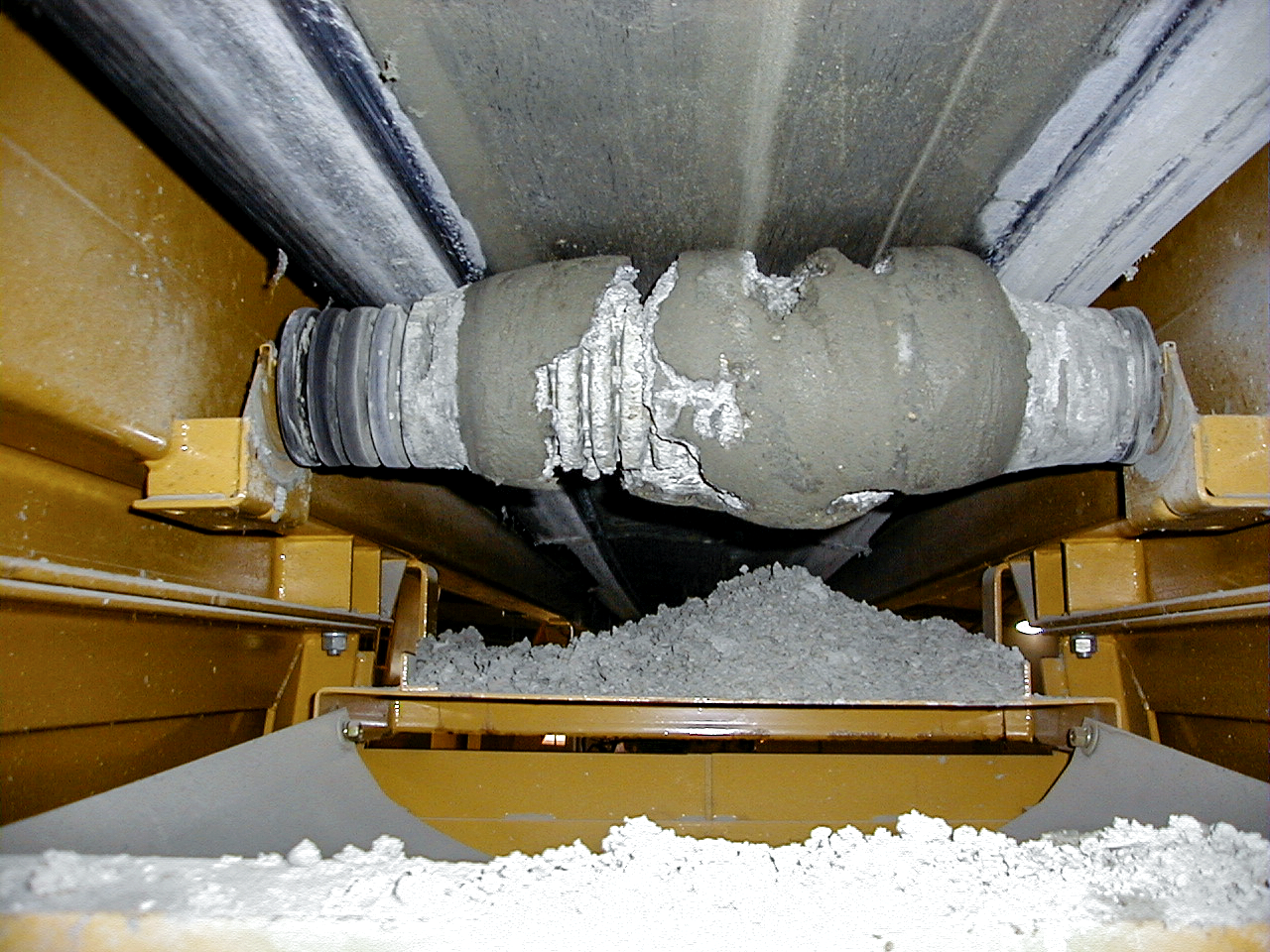By Seth Mercer on Oct 23, 2020 2:56:26 PM
All rolling conveyor components steer the belt (for better or worse)
Imagine heading out to your truck one morning only to discover that you had driven through wet concrete the night before and now your driver side tires are covered in a thick crust of fully dried concrete. Half of your truck now resembles something Fred Flintstone would drive. Good luck making it to work on time, let alone anywhere at all in a straight line.

Sounds dumb, but it actually happens
The dried concrete packed on your driver side tires is going to cause you to fight the steering wheel the whole way as the truck follows its newfound tendency to pull to the driver’s side. The concrete on those tires has thrown off the balance of the four rolling components of your vehicle, rendering it incapable of maintaining a straight course and raising the likelihood that a significant bill from the body shop is in your future.
When you see material carryback built up on the return run rollers of your belt conveyors, you’re looking at the exact same problem.
What is carryback and how does it affect rolling components?
Carryback is material that adheres to the belt past the discharge point of the head pulley and is carried back to the tail pulley on the return run. Carryback is typically material in its worst state; smaller particles with higher moisture content than the general cargo load.
Vibration of the belt as it travels over idlers creates a settling action. The smallest particles of material, along with excess moisture, settle to the bottom of the load where they create a highly adhesive mixture not unlike wet concrete. Adhering to the belt while the remainder of the load is discharged, this residual material travels back along the return run and subsequently sticks to the rolling components it meets along the way.
As this carryback material builds up on these rolling components, it does so unevenly and causes the belt to start veering off course. Your problem just went from bad to worse. The carryback that finally loses its grip on the belt and these components falls to the ground and begins piling up below, but that’s a whole  .
.
In the worst case scenario, severe material build-up can cause these rolling components to lock up. The resulting increase in friction adds load to the motor of the drive pulley and will almost definitely cause damage to the belt surface, further compounding your problems.

Carryback = pretty much wet concrete and not good for conveyors
How to address belt mistracking
There are numerous reasons a conveyor belt might mistrack, but no matter the cause, it's a problematic situation. Material accumulation on rolling components will certainly cause your belt to wander off course, and there are a few actions you can take to address it.
Belt tracking systems guide the conveyor belt to maintain proper alignment
Belt tracking devices work like a pair of hands firmly planted at 10 and 2 (flash back to driver's education class) on the steering wheel of your vehicle. They’ll course-correct your wandering belt and make sure it makes it from tail pulley to head pulley without straying off into conveyor structure, tearing up its edges while shearing off a support or cutting through chute work. For wayward belts, these devices can help you avoid further material spillage and costly damage to the belt and conveyor structure.

Belt damage caused by contact with conveyor structure due to mistracking
Belt cleaners eliminate carryback at its source
When material buildup on rolling components is present and causing or contributing to belt mistracking, it’s much easier and more effective to address the problem at its origin. To greatly reduce the amount of carryback your belt is depositing on these rolling components (and everywhere else), a proper set of primary and secondary belt cleaners—or scrapers, wipers, etc.—will help ensure that material is discharged at the head pulley and isn’t wreaking havoc on your conveyor system. Belt cleaners can even be installed at snub, take-up, and other pulleys if necessary.

A multi-cleaner system effectively removes carryback, greatly reducing or eliminating material buildup on rolling components that can cause the belt to mistrack
Primary belt cleaners as a first line of defense
Primary cleaner blades are typically made of urethane and are installed with low blade-to-belt pressure at a peeling angle to remove the bulk of material carryback. A good primary cleaner, properly specified and tensioned, will typically remove 50-70% of carryback. The remaining carryback is especially fine and sticky and has a high likelihood of adhering to rolling components. If that’s the case, a tungsten carbide secondary cleaner should effectively minimize or eliminate any potential for build-up.
Secondary belt cleaners as a second line of defense
Secondary cleaners are installed with optimum belt-cleaning pressure at a scraping angle just past the point where the belt leaves contact with the head pulley. Secondary blades feature tungsten carbide tips and perform final, precision removal of residual material fines that can slowly, but surely, build-up elsewhere down the conveyor.
Fully Understanding the Problem Leads to Fully Solving the Problem
As previously mentioned, material carryback isn’t necessarily the only reason your belt may be mistracking. The best way to ensure you are minimizing belt and component damage, material loss, and safety hazards is to leverage the insights from experienced and knowledgeable conveyor system experts.

Martin Engineering has been the leader in helping operations improve their bulk material handling systems for over 75 years. If you’ve got a conveyor belt that needs set straight, give us a holler. You can send a message via live chat or leave a comment right here on this page, shoot us an email at info@martin-eng.com, or give us a call at 800-544-2947.






comments